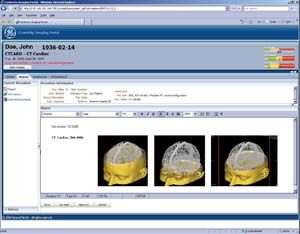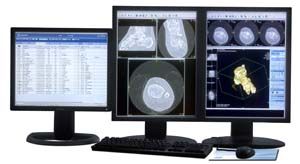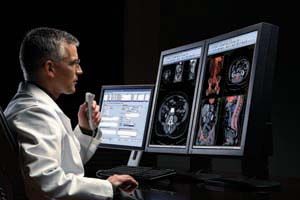Maturing PACS market gravitates toward regional solutions
Are there any limits to what can be achieved with new PACS technologies? Yes, of course. But sometimes it seems that the only restrictions are those imposed by the scope of the human imagination.
Are there any limits to what can be achieved with new PACS technologies? Yes, of course. But sometimes it seems that the only restrictions are those imposed by the scope of the human imagination.
Not so long ago, the first PACS were created to serve the information storage and communication needs of a particular imaging modality. Later they were designed to integrate information from all modalities used in the radiology department, and then to assist decision-making for clinical staff throughout the hospital. Now there are systems being built to provide clinically efficient and cost-effective data management solutions for whole networks of hospitals across a region, and these are on show in the ECR's technical exhibition.

Centricity Imaging Portal from GE is expected to be commercially available later this year. It allows radiologists to share a global patient history with colleagues working in other medical disciplines and at other centers in the network. (Provided by GE Healthcare)
Carestream is demonstrating SuperPACS, an architecture designed to integrate multiple PACS located at different sites and supplied by different vendors into a single enterprise solution.
"Factors like the aging population in developed countries are putting increasing pressure on health systems," said Ulf Andersson, Carestream Health's marketing director for northern Europe. "The only way to continue providing a high standard of healthcare is to optimize the working time of all medical professionals, and particularly radiologists. That is why we are seeing the consolidation of resources into large regional units. In Scotland, for example, 39 individual hospitals have now been linked by a single PACS solution. We will see that happening more and more in other countries."
Crucially, in today's difficult economic climate, the SuperPACS concept allows healthcare providers to form these networks without incurring the costs of replacing existing RIS/PACS solutions. The new technology, being shown as a work-in-progress at ECR but available for shipping by around mid-2009, can help drive improvements in workflow and productivity. It will help create a common global worklist, allowing images and reports originating anywhere within the enterprise to be examined by radiologists onsite or offsite, Andersson said.
Another feature of the system is its real-time volume-matching and automatic registration for CT, MR, and PET/CT examinations.

GE's Centricity PACS-IW workstations form an integral part of the company’s range of PACS products. (Provided by GE Healthcare)
"Synchronising the views from multiple data sets will allow radiologists to make rapid and accurate comparisons between the key anatomical structures, leading to improvements in report turnaround time and enhancing diagnostic accuracy," Andersson said.
Regional e-health projects are also driving GE Healthcare forward with three interlinked developments of its Centricity PACS on show at ECR 2009. The Centricity Imaging Portal will be commercially available later this year and will allow radiologists to share a global patient history with colleagues working in other medical disciplines and at other centers in the network.
"This is how we can improve the quality of care for our patients, because it allows access to the complete patient history, not just his or her radiological history. It will also become an important tool for multidisciplinary team meetings to discuss specific cases," said Ben Bauerschaper, general manager of imaging solutions for GE Healthcare's Europe region.
Two other applications are already available: the Centricity Advanced WEB and the PACS-IW web-based PACS. The former is designed to meet the demands of referring physicians for advanced tools and features GE's patented "pixel on demand" streaming technology.
"Even in situations with low bandwidth, this solution allows access to a broad set of tools with a simple internet connection: MIP/MPR (maximum intensity projection/multiplanar reformatting), integrated ultrasound, mammography and orthopedic tools, easy second opinion consulting, printing and burning of CDs from any PC, and a lot more," Bauerschaper said.
PACS-IW is designed to meet the demands of physicians working in small- to medium-sized hospitals for advanced postprocessing. It is user-friendly and easy and fast to install yet offers modern clinical tools such as MIP/MPR and advanced 3D technology, which are necessary to readily evaluate large data sets, according to Bauerschaper.
As the power and complexity of PACS continue to grow, so will the potential for problems if and when the system breaks down. Philips' goal is to relieve hospital managers of the worry of dealing with such eventualities through the service delivery model for its iSite PACS installations, under which customers pay only for their use of the facility. This business model is common in other parts of the IT industry, and Philips representatives will be explaining what they see as the advantages of this arrangement for visitors to the company's booth.
Philips' determination to innovate is further demonstrated by the presence in its ECR booth of representatives of third-party companies developing novel applications for use with the iSite system.

PACS promises to boost productivity and efficiency of radiologists, IT staff, and other clinicians. (Provided by Carestream)
"It is part of our business strategy to provide customers with increased functionality," said Wilbert Benschop, marketing manager for healthcare informatics with Philips. "Our partners are small software development companies that may be providing a solution needed only at a local level. It makes use of our open interface, and we will support in developing the application."
An example of this arrangement would be a software company that has created an application enabling radiologists carrying out an examination to compare the images onscreen with those in a database of pathologies from previous examinations.
As the PACS industry matures, there are increasing numbers of smaller companies providing specialist services. One of these is PACSGear, best known as a supplier of document and multimedia connectivity solutions. This year it is demonstrating a new product that received marketing approval in the EU only a few weeks ago, an encryption application for its MediaWriter CD burning technology.
"The security of medical records carried on DICOM CDs is becoming a concern in many countries of the world. In the U.K., the Department of Health last year insisted that any CDs carrying such data should have security protection to protect patient confidentiality in the event that they get lost. Other countries may introduce similar controls, so our encryption system is a simple and inexpensive way of meeting those requirements," said Thomas Pickard, vice president for marketing and research development.
Agfa HealthCare came into ECR 2009 in a buoyant mood, having been selected by King Edward VII's Hospital Sister Agnes in London as the provider for its RIS, PACS, and computed radiography systems. According to the vendor, its fully integrated IT solutions will transform the hospital's information workflow, improving efficiency and productivity and delivering high-quality services to staff and patients alike. At the independent acute hospital, Agfa will install Impax RIS, Impax PACS, and two CR 35-X digitizers with NX workstations.
Sectra, too, has every reason to be upbeat. For the second consecutive year, the company was ranked number two in the KLAS Community Hospital PACS 2008 report. KLAS monitors vendors' performance through active participation of healthcare organizations. Its report categorizes each vendor product into a market segment in which similar products are compared and ranked based on data reported by healthcare professionals.
Finally, prior to ECR 2009, Fujifilm celebrated reaching a notable landmark: the 650th global installation of its Synapse PACS. This underlines just how ubiquitous digital systems have become.
New Analysis Forecasts Substantial Cost Savings with the Use of Photon Counting CT for CCTA
March 8th 2025The use of ultra-high-resolution photon-counting CT in the evaluation of stable chest pain may significantly reduce follow-up tests and invasive coronary angiography (ICA) procedures, possibly resulting in millions in health-care cost savings, according to a cost-effectiveness analysis presented recently at the European Congress of Radiology.
Can Deep Learning Ultra-Fast bpMRI Have an Impact in Prostate Cancer Imaging?
March 3rd 2025A deep learning-enhanced ultra-fast bpMRI protocol offered similar sensitivity for csPCa as mpMRI with an 80 percent reduction in scan time, according to research findings presented at the European Congress of Radiology (ECR) conference.
ECR Mammography Study: Pre-Op CEM Detects 34 Percent More Multifocal Masses than Mammography
February 28th 2025In addition to contrast-enhanced mammography (CEM) demonstrating over a 90 percent detection rate for multifocal masses, researchers found that no significant difference between histological measurements and CEM, according to study findings presented at the European Congress of Radiology.
ECR Study Finds Mixed Results with AI on Breast Ultrasound
March 6th 2024While adjunctive use of AI led to significantly higher specificity and accuracy rates in detecting cancer on breast ultrasound exams in comparison to unassisted reading by breast radiologists, researchers noted that 12 of 13 BI-RADS 3 lesions upgraded by AI were ultimately benign, according to research presented at the European Congress of Radiology.
Can Autonomous AI Help Reduce Prostate MRI Workloads Without Affecting Quality?
March 1st 2024Based on findings from a multicenter study of over 1,600 patients, researchers at the European Congress of Radiology suggest the inclusion of autonomous artificial intelligence (AI) triage could facilitate up to a 75 percent reduction in prostate MRI reading workload.